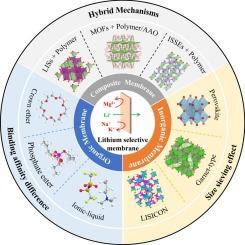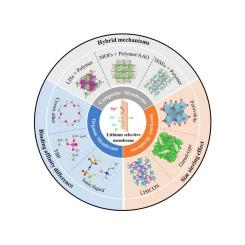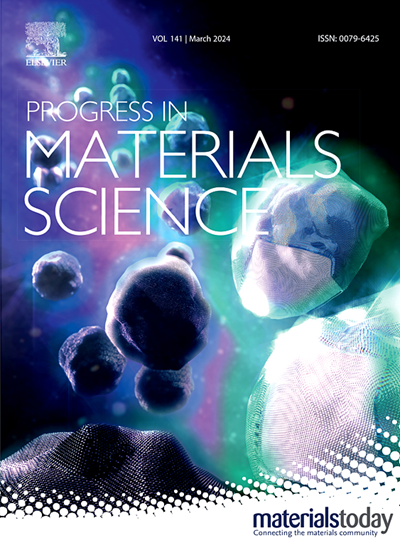锂选择膜直接从复杂卤水中提取锂
IF 40
1区 材料科学
Q1 MATERIALS SCIENCE, MULTIDISCIPLINARY
引用次数: 0
摘要
膜分离技术是一种有效的锂提取方法,具有环境可持续性和连续生产可行性等优点。随着高品位锂资源的日益枯竭,提取模式必须转向处理复杂卤水和海水,这些卤水的特点是超低Li+浓度和高竞争离子含量,特别是Na+、K+和Mg2+。锂选择膜(lsm)已成为从非常规资源中可持续提取锂的关键推动因素。尽管已经提出了各种lsm,但缺乏对其锂选择性萃取机理和性能的系统总结和分析。本文从粒径筛分效应、结合亲和性差异和杂化机制三个方面对lsm进行了系统的分类。详细分析了lsm中组成-结构-性能的关系。分析了用于lsm制备的各种功能材料(包括无机固态电解质、离子液体、磷酸酯、冠醚、锂离子筛和金属有机骨架)的特性。此外,本文还讨论了lsm的关键技术挑战,并提出了未来可能的研究方向,为高性能lsm的设计、制造和应用提供可行的建议。本文章由计算机程序翻译,如有差异,请以英文原文为准。


Lithium selective membranes for direct lithium extraction from complex brine
Membrane separation technology is an effective method for lithium extraction, boasting advantages such as environmental sustainability and continuous production feasibility. As high-grade lithium resources become increasingly depleted, the extraction paradigm must shift toward processing complex brines and seawater, which are characterized by ultra-low Li+ concentrations and a high content of competing ions, particularly Na+, K+, and Mg2+. Lithium selective membranes (LSMs) have emerged as critical enablers for sustainable lithium extraction from unconventional resources. Despite various LSMs have been proposed, there is a lack of systematic summarization and analysis of their lithium selective extraction mechanism and performance. This review systematically classifies state-of-the-art LSMs based on the lithium selective mechanisms of size sieving effect, binding affinity difference and hybrid mechanisms. The relationships of composition-structure–property in LSMs are analyzed in detail. The characteristics of various functional materials (including inorganic solid-state electrolytes, ionic liquids, phosphate esters, crown ethers, lithium ion-sieves, and metal–organic frameworks) used in the fabrication of LSMs are analyzed. Additionally, this review discussed the key technical challenges of the LSMs, and presented the potential future research directions to provide viable recommendations for the design, fabrication, and application of high-performance LSMs.
求助全文
通过发布文献求助,成功后即可免费获取论文全文。
去求助
来源期刊

Progress in Materials Science
工程技术-材料科学:综合
CiteScore
59.60
自引率
0.80%
发文量
101
审稿时长
11.4 months
期刊介绍:
Progress in Materials Science is a journal that publishes authoritative and critical reviews of recent advances in the science of materials. The focus of the journal is on the fundamental aspects of materials science, particularly those concerning microstructure and nanostructure and their relationship to properties. Emphasis is also placed on the thermodynamics, kinetics, mechanisms, and modeling of processes within materials, as well as the understanding of material properties in engineering and other applications.
The journal welcomes reviews from authors who are active leaders in the field of materials science and have a strong scientific track record. Materials of interest include metallic, ceramic, polymeric, biological, medical, and composite materials in all forms.
Manuscripts submitted to Progress in Materials Science are generally longer than those found in other research journals. While the focus is on invited reviews, interested authors may submit a proposal for consideration. Non-invited manuscripts are required to be preceded by the submission of a proposal. Authors publishing in Progress in Materials Science have the option to publish their research via subscription or open access. Open access publication requires the author or research funder to meet a publication fee (APC).
Abstracting and indexing services for Progress in Materials Science include Current Contents, Science Citation Index Expanded, Materials Science Citation Index, Chemical Abstracts, Engineering Index, INSPEC, and Scopus.
 求助内容:
求助内容: 应助结果提醒方式:
应助结果提醒方式:


